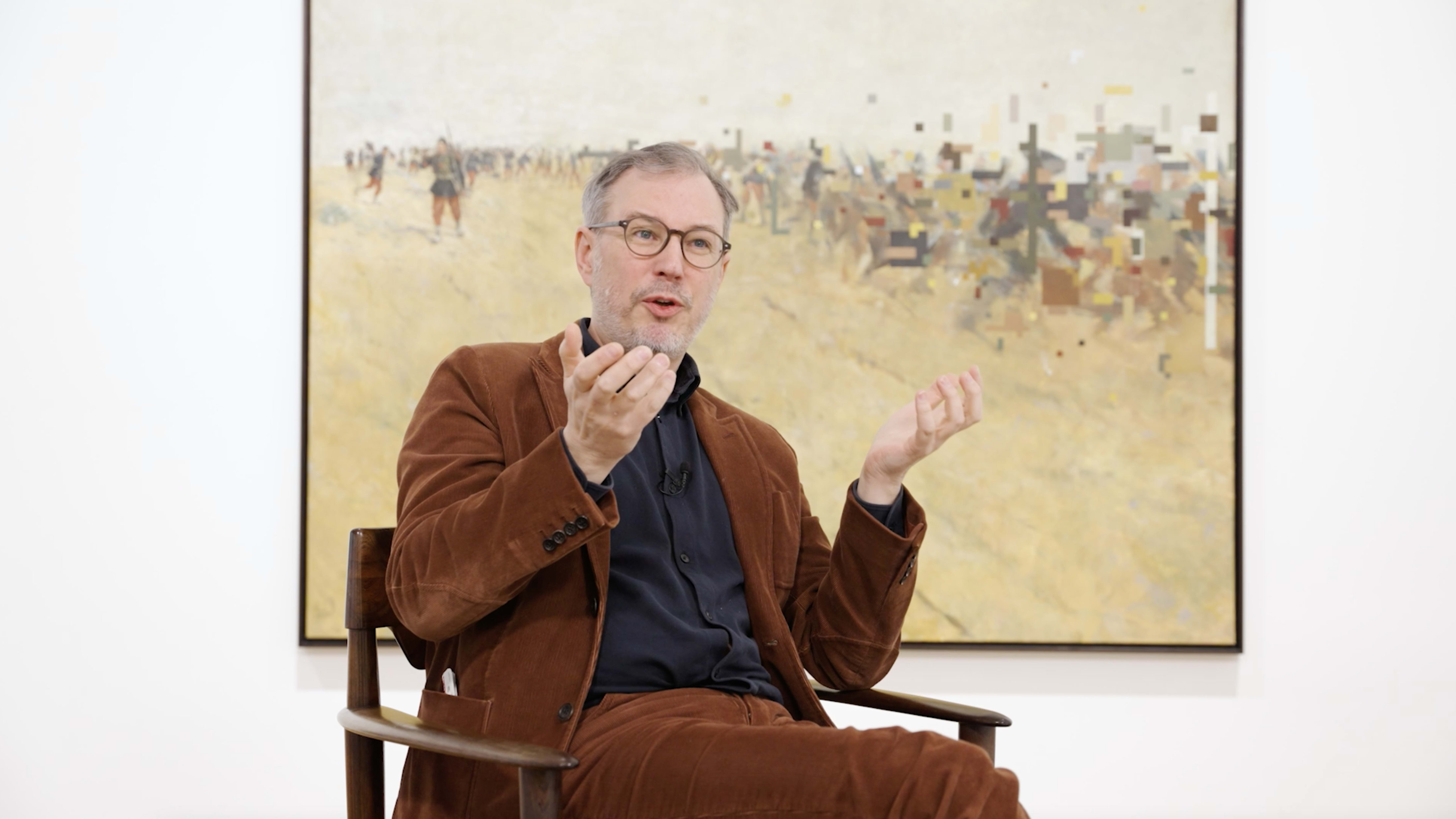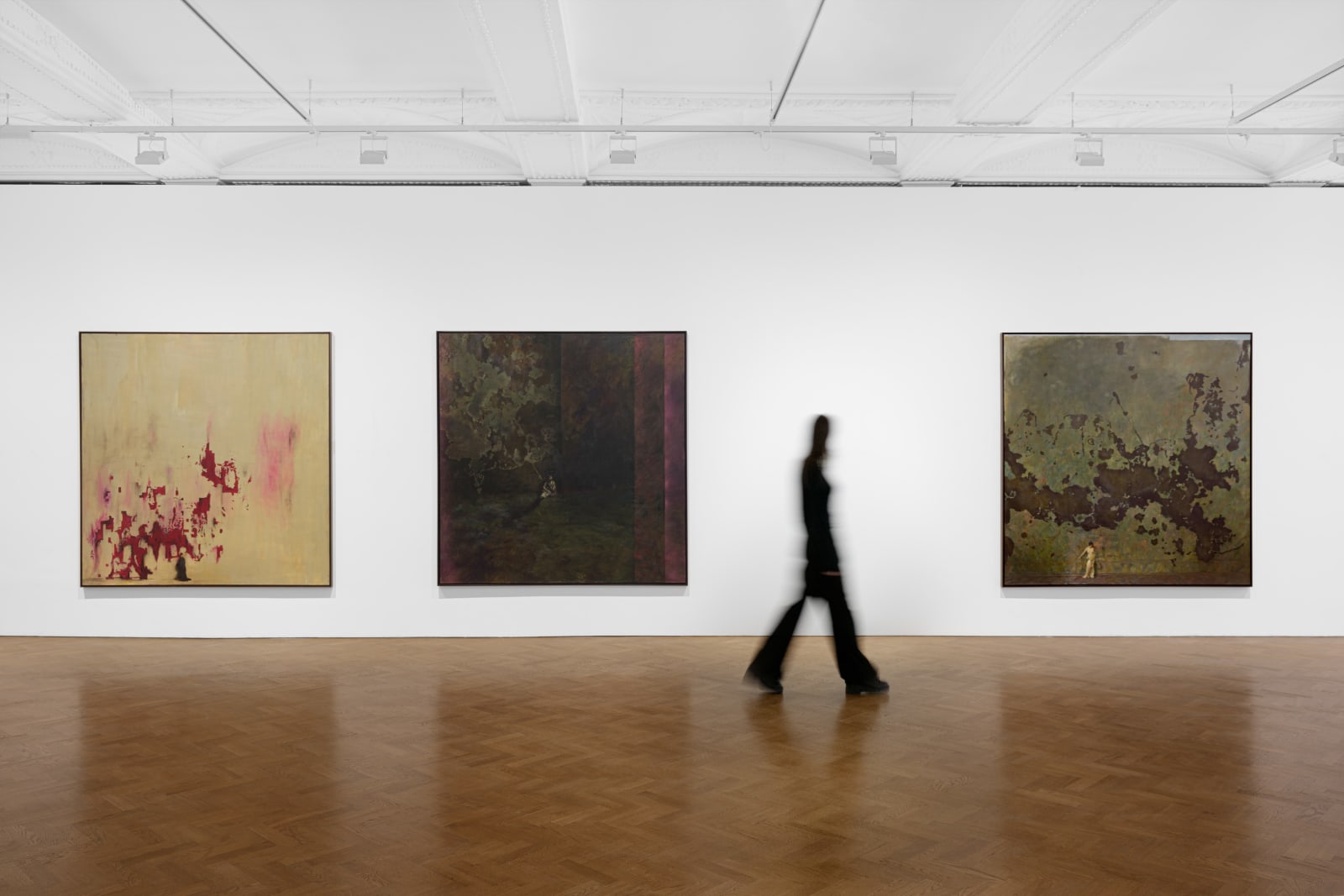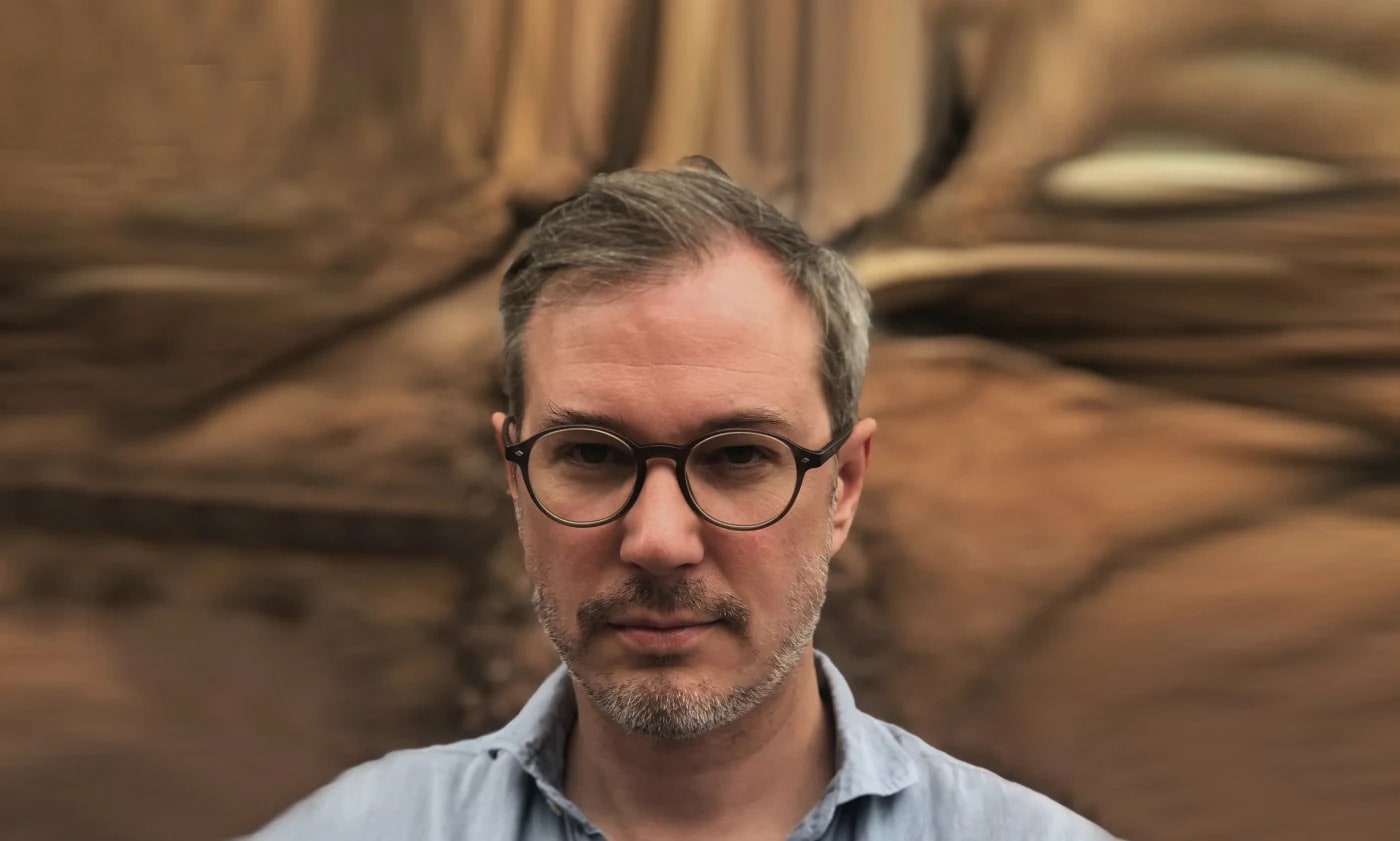Overview
For his first solo exhibition in the UK, acclaimed Austrian artist Markus Schinwald presents a group of large-scale oil paintings belonging to the same series featured in his celebrated installation Panorama (2022), shown at the 16th edition of the Lyon Biennale. He employs a painterly visual language that oscillates between abstraction and figuration, the past and the present, incorporating technoid blurs of pixels and vertical purple lines suggestive of numerical glitches on a computer. Representing Schinwald’s interest in reconfiguring historical imagery and modes of production within distinctly contemporary frameworks, the paintings are displayed alongside anthropomorphic wooden sculptures made from antique furniture and a selection of black-and-white prints of erased monuments.
For his first solo exhibition in the UK, acclaimed Austrian artist Markus Schinwald presents a group of large-scale oil paintings belonging to the same series featured in his celebrated installation Panorama (2022), shown at the 16th edition of the Lyon Biennale. He employs a painterly visual language that oscillates between abstraction and figuration, the past and the present, incorporating technoid blurs of pixels and vertical purple lines suggestive of numerical glitches on a computer. Representing Schinwald's interest in reconfiguring historical imagery and modes of production within distinctly contemporary frameworks, the paintings are displayed alongside anthropomorphic wooden sculptures made from antique furniture and a selection of black-and-white prints of erased monuments.
Following a series of solo exhibitions in Europe and the USA, Schinwald cemented his international reputation at the 54th Venice Biennale in 2011, when he filled the Austrian Pavilion with a labyrinthine structure suspended from the ceiling. His interdisciplinary approach to artmaking encompasses video, performance, dance, theatre, painting, photography, sculpture and installation. Exhibited widely in solo and group presentations, Schinwald's work is held in prominent collections, including that of The Museum of Modern Art (MoMA), New York; SFMoMA, San Francisco; Museum Belvedere, Vienna; Hamburger Kunsthalle, Hamburg; Musée d'Art Moderne de Paris; Kunsthaus Zürich; and Tate, London.
The large square-format paintings presented in the exhibition mark a key development in Schinwald's approach to working with historical art objects. Previously, he painted complex prostheses over the faces of subjects depicted in 19th-century portraits. Appropriating academic painterly techniques to apply paint directly to the original canvases, he explains the process as 'altering history and giving artworks a second life'. In 2016, a notable shift occurred in Schinwald's practice when he started integrating historic paintings into larger canvases. Through a technique that combines restoration and suturing methods, the old canvas is inset in a larger format. The new additions are painted with variegated fields of colour that dwarf the original images within vast landscapes and architectural spaces, emphasising the relationship between their bodily presence and their surroundings.
Recent additions to this body of work are characterised by a preoccupation with the digital world. Schinwald explains that the work 'is based on a digital grammar of augmented reality and artificial intelligence, but uses the vocabulary of the past.' By integrating pixelated elements into the paintings, his objective is to challenge our perception of images. Particularly in the deconstructed battle scenes, Schinwald calls into question totalising narratives of history, which are too often told as a sequence of victories and defeats. Fusing art-historical traditions with the visual grammar of digital technologies allows the artist to alter the conventions of paintings that 'do not fit the climate of our time' in such a way 'that they can exist under contemporary conditions.'
I'm interested in alternative methods of historiography. While traditional art history establishes a teleology of the progression and development of images, my approach is non-mensual. These are attempts at a future historiography - as with science fiction, they are place-holders for a future memory, built with fragments of the past. Just before the old images recede, they catch the light for a final time. — Markus Schinwald
Alongside the canvases, Schinwald presents a group of sculptures fashioned from the legs of antique tables. These composite wooden forms, which have appeared in his practice for over a decade, reference the distinctive Chippendale style developed by English furniture maker Thomas Chippendale in the 18th century to emulate the shape of human legs. Recognising the 'subtly erotic' potential of these appendages, Schinwald dismantles the legs and 'puts them together the wrong way' to create suggestive anthropomorphic sculptures. Freestanding or wrapped around metal poles, the sculptures belong to an uncanny mode of figurative abstraction, heightened by the elongated form of the lithe wooden limbs.
While the leg sculptures summon a sense of bodily presence, the prints in the exhibition conversely deal with its absence. Belonging to Schinwald's 2009 Monuments series, plinths, cenotaphs and memorial fountains are rendered strange by the absence of the figures typically posed atop these stone structures. Schinwald's conceptual act of vandalism strips away the original meaning of the memorials, presenting the viewer with an undecipherable monument. As with the analogous treatment of historical themes in his paintings, he undermines the conventions of nationalistic narratives as he asks what is being commemorated and why - questions that have only increased in relevance following recent debates concerning the function of public sculptures.
Driven by Schinwald's deep interest in the nature of embodied perception as conceived by French theorist Maurice Merleau-Ponty (1908-61), the exhibition prompts visitors to consider the relationship of their own bodies to the works on view. They are drawn into the expansive landscapes of the paintings, share space with uncanny humanoid sculptures and are confronted with the absence of the bodies atop the monuments, evidencing the powerful connection between artist, viewer and artwork fostered by Schinwald through his interdisciplinary practice.
Markus Schinwald: Extensions and Monuments is presented alongside two concurrent solo exhibitions at Thaddaeus Ropac London: Rona Pondick: Selected Work 1998-2022 and a presentation of paintings from Lee Bul's Perdu series.
Video

With the logic of a computer, of algorithms, we have a chance to mine historical material. To construct the images for the future with fragments of the past. And that’s what I’m trying to do with my paintings as well.
— Markus Schinwald
Untitled (extensions), 2019
Oil on canvas
200 x 200 cm (78.74 x 78.74 in)
















































































































































































